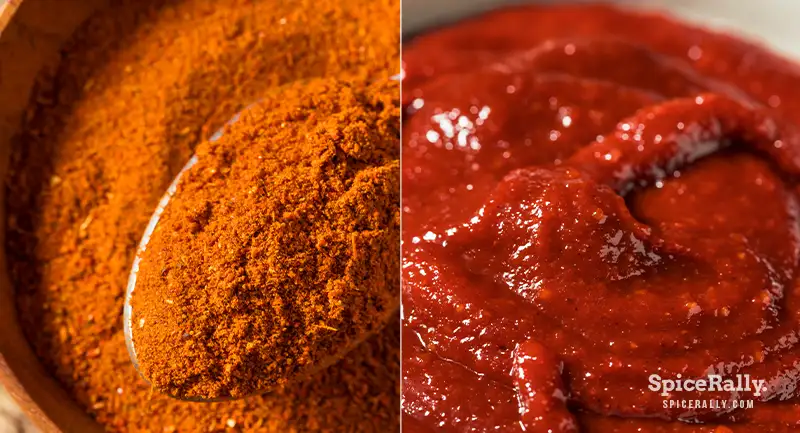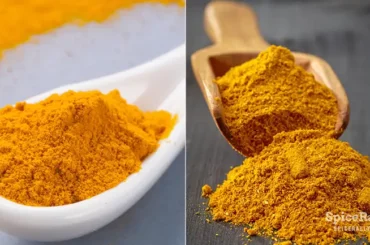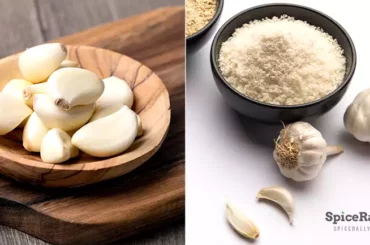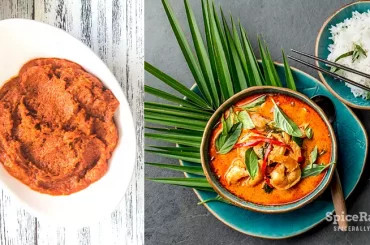If you love Thai foods, “curry” is not something exotic to you. So, we thought of sharing all the information on Thai curry powder vs Thai red curry paste that could be useful to you when cooking Thai dishes.
The first major difference between Thai curry powder and Thai red curry paste is that curry powder is basically a mixture of dried, toasted ground spices. In contrast, red curry paste is a wet blend with a certain amount of moisture. Also, Thai red curry paste tends to be spicier, more intense, and more flavorful than Thai curry powder, making them somewhat different in usage in cooking as well.
So, let’s dive in and learn further about how these two Thai staples compare!
Thai Curry Powder Vs Thai Red Curry Paste

| Thai Curry Powder | Thai Red Curry Paste | |
|---|---|---|
| Base flavor | Warm and spicy | Spicy and savory |
| Flavor profile | Mild, less intense, with earthier, warm, and spicy undertones. Thai curry powder tends to be typically less piquant than Thai red curry paste. | More flavorful with robust, potent, and spicier flavor notes. Thai red curry paste holds a more “curry” undertone than Thai curry powder with a vivid, bold flavor profile. |
| Ingredients | – Turmeric – White pepper – Bay leaves – Coriander – Cumin – Red chili flakes/ powder – Ginger/ galangal – Cloves Might also include the following: – Chili powder – Garlic powder – Ground nutmeg – Onion powder – Dried parsley – Ground cinnamon – Dried basil | – Garlic – Galangal/ ginger – Ground coriander seeds – Lemongrass – Coriander root (cilantro root) – White pepper/black pepper – Ground cumin seeds – Shallots – Kaffir lime peel – Shrimp paste Salt Fish sauce/ soy sauce (in some recipes) |
| Texture | A dry, fine powder | A wet, thick paste |
| Color | Has a yellowish color and is less vibrant than Thai red curry paste. | Bright brownish-red and more vibrant than Thai curry powder. |
| Mode of usage in cooking | As an ingredient | As an ingredient |
Click on this link and discover more interesting facts about Thai curry powder and its ingredients
| Usage in cooking | – Can be tossed with fried foods and snacks when mixed with a little bit of salt – Used to make curries and gravies – Flavors soups and stews – Can be incorporated into wet rubs and marinades to season meat and seafood – Flavors a variety of vegetable dishes | – Ideally used as a base for coconut milk-based curries, broths, soups, or stews. – To be used as a flavor enhancer in marinades and wet rubs. – Used in rice, pasta, noodles, and spaghetti dishes. – It can be mixed into meat, eggs, or fish dishes. – To be blended into sandwich or wrap spreads. |
| Origin | Thai cuisine | Thai cuisine |
| Mode of production | Both domestic and store-bought options exist. | Both domestic and store-bought options exist. |
| Availability | Can be bought from supermarkets, Asian groceries, or online shopping sites under a few brand names. | Readily available in supermarkets, Asian grocery stores, and online vendors under many brand names. |
| Storage | Could be stored with the rest of your dry spices or seasonings in an air-tight spice container/shaker/jar. | It should be stored in a tight-fitting container/jar. Can be kept in a dry, cool place in the pantry, refrigerated, or frozen in sealable freezer bags. |
| Culinary ingredient category | Spice blend/ mixture | Curry paste |
Elaborating On The Difference Between Thai Curry Powder And Thai Red Curry Paste
As you see, Thai curry powder and Thai red curry paste possess more dissimilarities than the visual and texture-wise differences we capture at once. However, both of them are staple ingredients in Thai cuisine but are used differently in various cooking methods.
The reason is unknown, but we see that curry pastes hold more popularity in Thai cooking than curry powder, while the red curry paste retains prominence. Moreover, due to its advanced content, Thai red curry paste tends to be more potent, piquant, and spicier.
It also has a more concentrated flavor and aroma than Thai curry powder. At the same time, Thai curry powder gets its taste and texture only from its few ground spices. Thai red curry paste works alone as a base for curries and soups, while Thai curry powder should often be combined with other ingredients as a foundation for curries or other liquid-based dishes.
Above all, Thai red curry paste typically contains shrimp paste or traces of fish, making it non-vegan-friendly most of the time. While on the contrary, Thai curry powder is always vegan-friendly as it does not traditionally contain any animal traces.
Can Thai Curry Powder And Thai Red Curry Paste Be Used Interchangeably?
Since Thai red curry paste and Thai curry powder share similar roots, you have the possibility to use them interchangeably in terms of flavor. However, it is important to remember that they are not the ideal substitutes for each other.
Thai red curry paste is much more flavorful than Thai curry powder, and Thai curry powder is milder and always vegan-friendly, while they also differ in their consistencies. Therefore, Thai red curry paste can be used in pinches in place of Thai curry powder in dishes that call for it as a secondary element and vice versa.




